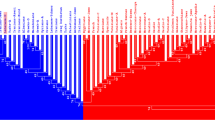Abstract
A total of 604 individuals living in Montevideo and other places in Uruguay were studied in relation to three I HLA loci. The most common alleles observed (percentages in parentheses) were A2(24), A9(15), A19(11), B12(12), B35(12), and C4(16). The most marked departures from linkage equilibrium (all numbers multiplied by 105) were B35-C4(636), A2-B5(590), A2C3(515), A2B14(494), and A19-B12(485). These findings do not contradict the hypothesis that while most of the Uruguayan population is of Caucasoid origin, significant African and Amerindian genes may exist in its gene pool.
Similar content being viewed by others
References
Arellano J., Vallejo M., Estrada H.G., and Kreschmer R.R., 1991.HLA profile of the Mexican Mestizo population. Tissue Antigens, 18: 242–246.
Ayres M., and Ayres M., Jr. 1987.ApplicaÇões Estatisticas em Basic.São Paulo: McGraw-Hill.
Baur M.P. and Danilovs J.A., 1980.Population analysis of HLA-A, B, C, DR, and other genetic markers. In (P.I. Terasaki, ed.). Histocompatibility Testing 1980, pp. 955–1210. Los Angeles: UCLA Tissue Typing Laboratory.
Bernal J.E., Duran C. and Papiha, S.S., 1988.HLA antigens in the Uitoto Indians and an urban population of Colombia. Hum. Hered., 38: 337–340.
Caraballo G.L.R., Marrugo C.J., Erlich H., and Pastorizo E.M., 1992.HLA alleles in the population of Cartagena (Colombia). Tissue Antigens, 39: 128–133.
Cavalli-Sforza L.L., and Bodmer W.F., 1971.The Genetics of Human Populations. San Francisco: W.H. Freeman.
Diaz J.W. and Cheredeev A.N., 1977.Distribution of HLA antigens in a Cuban population. Tissue Antigens, 9: 71–79.
Fernandez-Viña M.A., Gao X., Moraes M.E., Moraes J.R., Salatiel I., Miller S., Tsai J., Sun Y., An J., Layrisse Z., Gazit E., Brautbar C., and Stastny P., 1991.Alleles at four HLA class II loci determined by oligonucleotide hybridization and their associations in five ethnic groups. Immunogenetics, 34: 299–312.
Ferreira E., Ward F.E. and Amos D.B., 1975. HLA in a Brazilian population: evidence for new HL-A specificities. In. (F. Kissmeyer-Nielsen, ed.). Histocompatibility Testing 1975, pp. 226–232. Copenhagen: Munksgaard.
Fumeron, F., Feingold, N., Bois, E., Mayer, F., and Hors, J., 1981.Studies on an isolated West Indies population: I. Analysis of HLA genotypes. Tissue Antigens, 17: 338–342.
Giraudo C., Gomez V., and Marcellino A., 1982.Estudio immunogenético en un semiaislado humano de la Sierra de Comechingones (Cordoba, Argentina). Medicina (Buenos Aires), 42 (Suppl. 1): 51–55.
Gorodezky C., Escobar-Gutiérrez A., and Salazar-Mallén M., 1972.Distribution of some of the HL-A system lymphocyte antigens in Mexicans. I. Mestizo and Mexican Indian population. Vox Sang., 23: 439–443.
Gorodezky C., Teran L., and Escobar-Gutiérrez A., 1979.HLA frequencies in a Mexico Mestizo population. Tissue Antigens, 14: 347–352.
Haas E.J.C., Verruno L., and Raimondi E.H. 1986.El Sistema HLA.Buenos Aires. Editorial Universitaria.
Helmuth, R., Fildes N., Blake, E., Luce M.C., Chimera J., Madej R., Gorodezky C., Stoneking M., Schmill N., Klitz W., Higuchi R. and Erlich H.A., 1990.HLA-DQ allele and genotype frequencies in various human populations, determined by using enzymatic amplification of oligonucleotide probes. Am. J. Hum. Genet., 47: 515–523.
Layrisse Z., Pulido de Rodriguez M., Rodriguez-Iturbe B., Garcia E., Stoikow Z. and Salas G., 1976.Genetics of the HL-A system in a Venezuelan heterogeneous population. Vox Sang. 31: 37–47.
Liau S.W., Mickey R., Romano P., and Lee T.D., 1984.Study of the HLA system in the Haitian population. Tissue Antigens, 23: 308–313.
Monplaisir N., Valette I., Lepage V., Dijon V., Lavocat E., Ribal C. and Raffoux C., 1985.Study of the HLA antigens of the Martinican population. Tissue Antigens, 26: 1–11.
Salzano F.M., and Callegari-Jacques S.M., 1988.South American Indians. A Case Study in Evolution. Oxford: Clarendon Press.
Sans M., Mañé-Garzon F. and Kolski R., 1986.Presencia de mancha mongolica en recién nacidos de Montevideo. Arch. Ped. Uruguay, 57: 149–156.
Sans M., Mañé-Garzón F. and Kolski R., 1991b.Utilización de marcadores genéticos para el estudio del mestizaje en la población uruguaya. Antrop. Biol. (Santiago), 1: 71–86.
Sans M., Sosa M., Alvarez I., Toledo R., Bengochea M. and Salzano F.M., 1992.Blood group frequencies and the question of race admixture in Uruguay. Interciencia (in press).
Trachtenberg A., Jobin L.F.J., Kraemer E., Salzano F.M., Moraes M.E.M., Moraes J.R.F., Gerbase-de-Lima M., Arce-Gomez B., and Ferreira E., 1988.The HLA polymorhism in five Brazilian populations. Ann. Hum. Biol., 15: 213–221.
Vogel F., and Motulsky A.G., 1986.Human Genetics. Problems and Approaches. Spring-Verlag: Berlin.
Author information
Authors and Affiliations
Rights and permissions
About this article
Cite this article
Alvarez, I., Sans, M., Toledo, R. et al. HLA gene and haplotype frequencies in Uruguay. Int. J. Anthropol. 8, 163–168 (1993). https://doi.org/10.1007/BF02446325
Received:
Accepted:
Issue Date:
DOI: https://doi.org/10.1007/BF02446325




